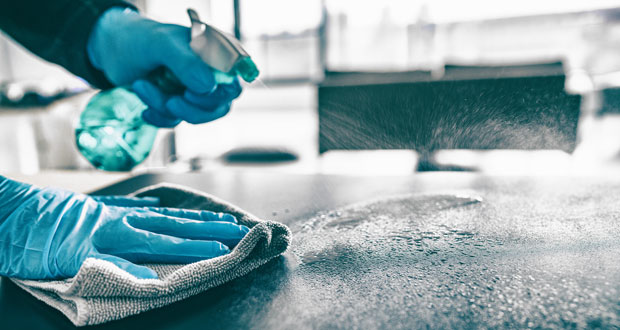 By Joshua Schwartz, the President and Co-Founder of Viking Pure Solutions
By Joshua Schwartz, the President and Co-Founder of Viking Pure Solutions
As managers and decision-makers responsible for the wellbeing of employees in office buildings, it’s crucial to recognise the impact that seemingly innocuous cleaning products can have on their health. While maintaining a clean workspace is essential, the chemicals found in many conventional cleaning products can contribute to respiratory issues such as asthma and allergies among employees.
In this article, we’ll explore why it’s imperative to prioritise the use of safer, more eco-friendly cleaning solutions to protect the health and productivity of your workforce.
The Chemical Conundrum:
Traditional cleaning products often contain a cocktail of harsh chemicals, fragrances, and irritants designed to kill germs and leave surfaces sparkling clean. However, many of these chemicals can linger in the air long after cleaning, leading to indoor air pollution and triggering respiratory problems for employees. Ingredients such as ammonia, bleach, and volatile organic compounds (VOCs) have been linked to asthma attacks, allergic reactions, and other respiratory issues, posing a significant risk to employee health.
The Office Environment:
In an office setting where employees spend the majority of their day indoors, poor indoor air quality can have serious consequences for health and wellbeing. Dust, pollen, mold, and other allergens can accumulate on surfaces, exacerbating existing respiratory conditions and causing discomfort for employees. When combined with the chemical emissions from commonly used cleaning products, the indoor environment becomes a breeding ground for respiratory issues, affecting employee morale, attendance, and productivity.
As stewards of employee health and safety, it’s incumbent upon managers and decision-makers to take proactive measures to minimise exposure to harmful chemicals in the workplace. One effective strategy is to transition to non-toxic cleaning solutions that are free from harsh chemicals, fragrances, and allergens. Eco-friendly alternatives such as electrolyzed water solutions offer effective cleaning power without compromising indoor air quality or employee health.
What is Electrolyzed Water?
Electrolyzed water, also known as electrolyzed oxidizing water (EOW) is created by passing an electric current through a saltwater solution. This process separates the water into two components: an alkaline cleaning solution (sodium hydroxide) and an acidic disinfecting solution (hypochlorous acid), both of which possess potent properties and are versatile for a variety of surfaces and applications.
Electrolyzed water is appealing for a number of reasons.
- Hypoallergenic: One of the most compelling reasons to embrace electrolyzed water is its hypoallergenic nature. Unlike many traditional cleaning chemicals that contain harsh irritants and allergens, electrolyzed water is gentle on the skin, respiratory system, and environment. This makes it an ideal choice for individuals with asthma, allergies, or sensitivities to harsh chemicals.
- Asthma-Friendly: Traditional cleaning chemicals often emit volatile organic compounds (VOCs) and other respiratory irritants that can trigger asthma attacks and exacerbate respiratory conditions. Electrolyzed water, on the other hand, produces no harmful fumes or vapors, making it a safer option for indoor environments where air quality is paramount.
- Effective Cleaning Power: Don’t let its gentle demeanour fool you—electrolyzed water packs a punch when it comes to cleaning power. The cleaner is a powerful degreaser and emulsifies on contact, while the e-water disinfectant is highly effective at killing bacteria, viruses, and other pathogens on surfaces, making both reliable choices for maintaining a clean and hygienic environment.
Why Electrolyzed Water Trumps Traditional Chemicals:
- Safety: Traditional cleaning chemicals pose numerous health and safety risks for users, including skin irritation, respiratory issues, and even long-term health consequences. Electrolyzed water offers a safer alternative, free from harmful chemicals and fragrances.
- Sustainability: Conventional cleaning products often contain harsh chemicals that can harm the environment and contribute to pollution. Electrolyzed water is produced using only water, salt, and electricity, making it a sustainable and eco-friendly choice for environmentally conscious consumers and businesses. Furthermore, it can be generated as ready-to-use solutions on-site at facilities to help buildings cut back on their plastic/packaging waste, carbon emissions and overall environmental footprint.
- Cost-Effectiveness: The long-term savings from implementing electrolyzed water can be significant. By reducing the need for multiple cleaning products and minimising health-related expenses, electrolyzed water offers a cost-effective solution.
The Business Case for Safer Cleaning Practices:
Beyond the ethical imperative of protecting employee health, there’s also a compelling business case for adopting safer cleaning practices in office buildings. By investing in non-toxic cleaning solutions, organisations can reduce absenteeism, healthcare costs, and employee turnover associated with respiratory illnesses. Moreover, promoting a healthier work environment demonstrates a commitment to corporate social responsibility and can enhance the organisation’s reputation as an employer of choice.
The use of conventional cleaning products in office buildings poses a significant threat to employee health and wellbeing. By prioritising the adoption of safer, more eco-friendly cleaning solutions, managers and decision-makers can create a healthier work environment that supports the productivity, morale, and longevity of their workforce. Together, let’s take a proactive approach to cleaning practices and safeguard the health of employees in office buildings.





